
On this month's Morbidly Fascinating Page:
Mental Institutions from the 19th to the 21st Centuries
In the Morbidly Fascinating Archives
Victorian Post-mortem Photography
Photographs of Ghosts
Mob Hits
Spontaneous Human Combustion
Deep Sea Creatures
Lunatic Asylums of the 1800s
The original meaning of the word asylum was a "retreat" or "sanctuary," and these institutions were originally intended to act for the protection of mental patients.
In the 1800s, asylums were institutions where the mentally ill were held. These facilities witnessed ineffective and cruel treatments of those who were hospitalized within them. In both Europe and America, these facilities were in need of reform. Patients with severe mental problems, also called lunatics in the medical profession at the time, were routinely subject to brutal techniques, such as ice baths.
In America, mental conditions such as depression, mania or melancholy could cause one to be admitted to a mental institution. These places resembled private madhouses rather than hospitals. Due to poor organizational structure and lack of quality services to patients, these madhouses left few, if any, records. To manage unruly patients, physical restraints were used. These places were obviously disastrous for all those who desperately needed psychiatric attention. Americans began to protest against patient abuse, and a call for reform rang out across the country.
Still, during the 1800s, many asylums continued to house the mentally ill in inhumane, filthy conditions due to overcrowding, lack of oversight, and cruelty of the staff. A few photos from this timeperiod are below:

A patient sits in a restraint chair at the West Riding Lunatic Asylum in Wakefield, England in 1869.

This photo was taken at the West Riding Lunatic Asylum in Wakefield, England circa 1869. At the time of this photo, she may have suffered from untreated, advanced syphillis. If syphilis goes untreated, the affected person is at risk of developing neurosyphilis. This is an infection of the nervous system, specifically of the brain and the spinal cord, producing severe personality changes.
Syphilis can involve almost any ocular structure (the eyes), but posterior uveitis and panuveitis are the most common presentations. Other common manifestations include interstitial keratitis, recurrent anterior uveitis, retinal vasculitis, and optic neuropathy. Ocular syphilis, if untreated, may lead to blindness.

A psychiatric patient at Paris' Salpêtrière Hospital circa 1876-1877.

An undated mid-1800s photo of families visiting a women's ward, probably in America.

Some in early institutions were identified by numbers, as shown by this photo from 1869.
Mental Institutions of the early 1900s sought to "fix" the patients.
Insane asylums began to decline around the begiinning of the 1900s. As patients with incurable illnesses filled them, asylums became warehouses for people who could not be maintained elsewhere. The St. Louis Insane Asylum exemplifies this trend of decline. Overcrowding and lack of funding led to placement of patients in the St. Louis Poorhouse and to unhealthy conditions at the asylum. Dr. Edward Runge, the superintendent, tried to counteract this trend of decline, but the asylum was able to offer little more than custodial care. It was during this timeperiod that insane asylums earned their bad reputations.
The St. Louis Insane Asylum in America was considered to have a progressive approach to care and treatment of individuals with mental illness. Dr. Edward Runge, the superintendent, advocated holistic treatments for a variety of diagnoses, including mania, melancholia, stupor, and general paresis. In an 1899 article in the American Journal of Insanity, Dr. Runge stated that “Cheerful surroundings, useful employment, entertainments, and other agencies of similar nature, have for their ultimate aim the production of healthy cerebration”.
The modern era of institutionalized provision for the care of the mentally ill, began in the early 20th century. National attention was focused on the routine use of bars, chains and handcuffs and the filthy conditions the inmates lived in.
A series of radical physical therapies were developed in central and continental Europe in the late 1910s, the 1920s and most particularly, the 1930s. Egas Moniz performed the first leucotomy, or lobotomy in Portual in 1935, which targets the brain's frontal lobes. This was adapted by Walter Freeman and James W. Watts in what is known as Freeman–Watts procedure or the standard prefrontal lobotomy. The two American doctors (Freeman and Watts) performed lobotomys beginning in the late 1930s all the way up to the mid-1960s.
Electroconvulsive therapy, or shock therapy, was a treatment that involveed sending an electric current through a patient's brain, causing a brief surge of electrical activity within the brain (also known as a seizure). The aim of the treatment was to relieve the symptoms of some mental health problems. Insulin shock therapy was meant to induce short-term comas.

Ohio mental hospital in the early 1900s.
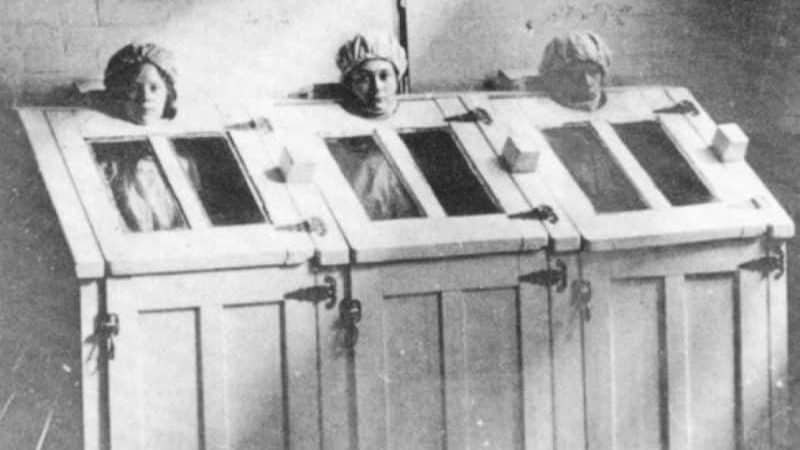
In the early 1900s, one of the "treatments" was forced immersion in cold water, which could last for hours.
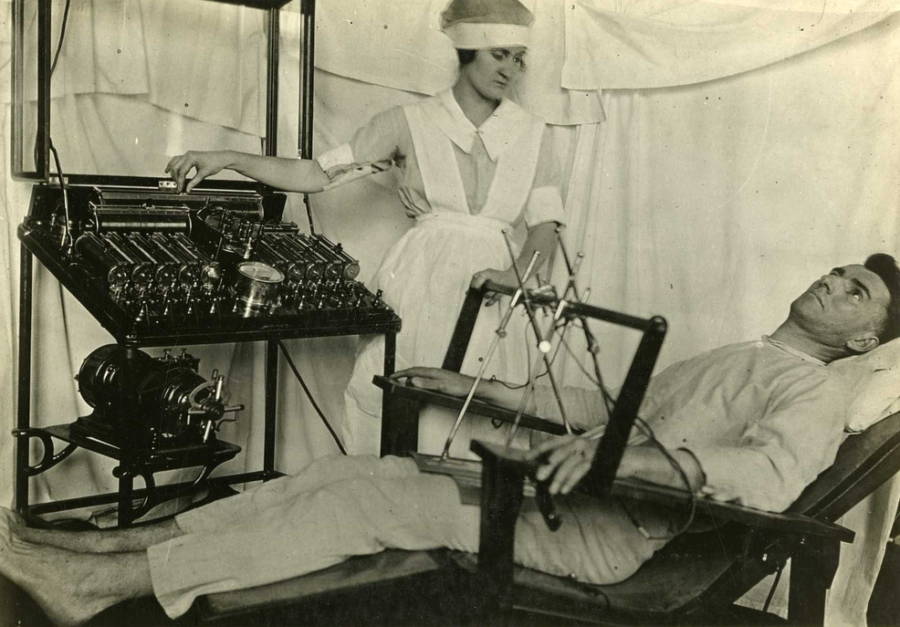
One of the earliest shock therapy apparatuses, circa 1914-1918.

Doctors tested radio-wave therapy in Paris in 1938.
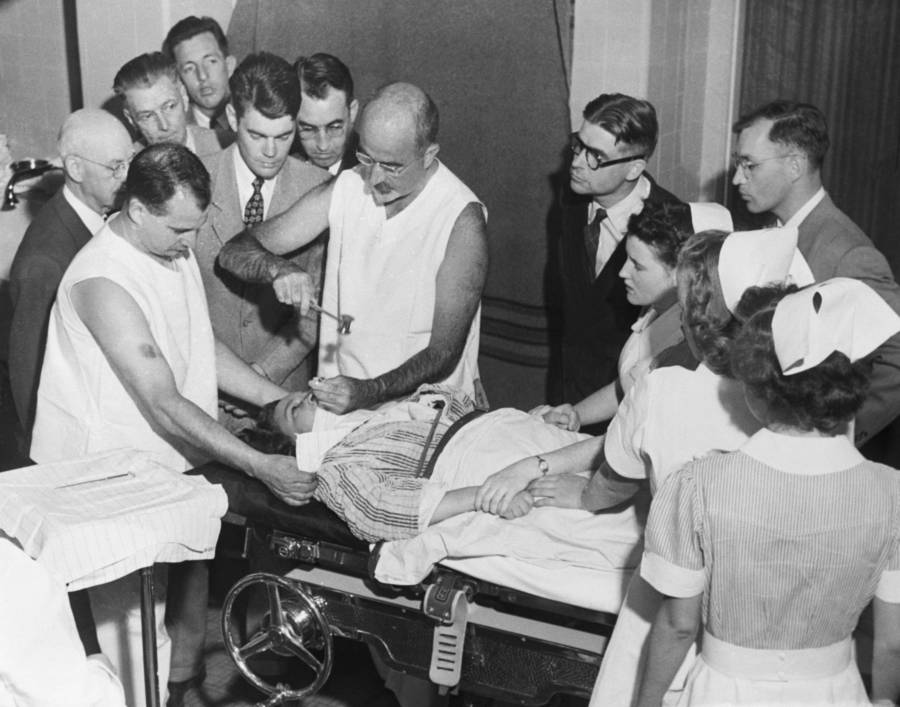
Prolific lobotomist Dr. Walter Freeman performs a lobotomy with an instrument similar to an ice pick at Western State Hospital in Lakewood, Washington State on July 11, 1949.
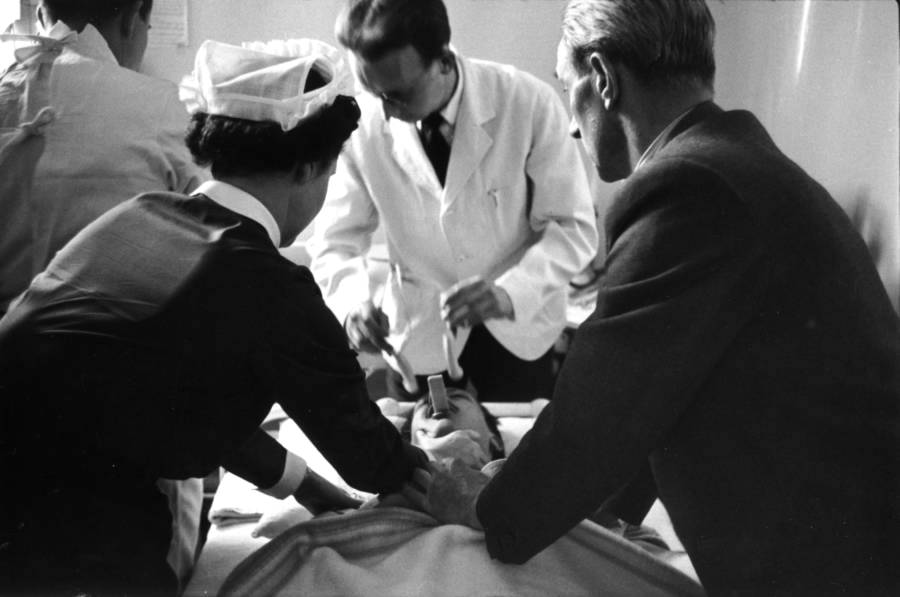
Setting a patient up for shock therapy in 1956.
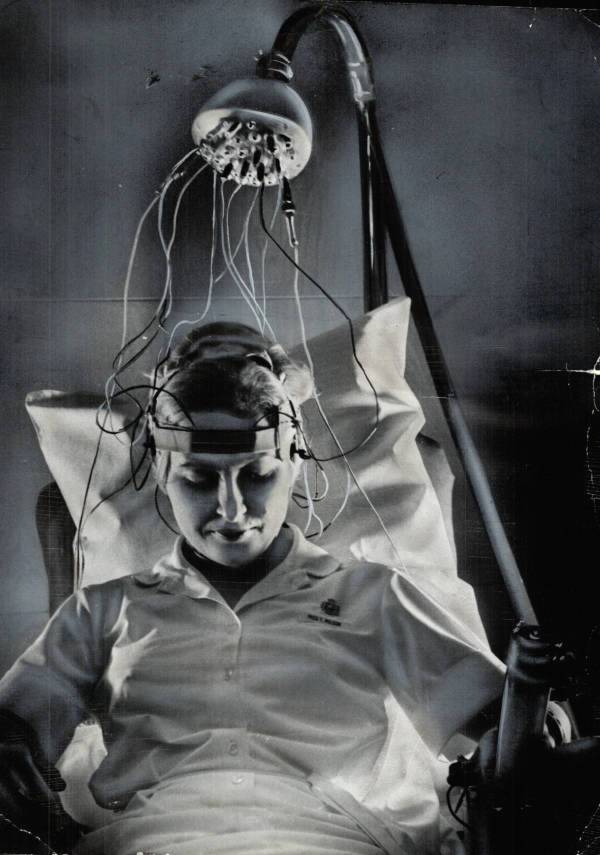
Wired apparatus used on a patient in Toronto, Canada in 1964.
Modern treatments for mental illness in the 21st Century
The late 20th Century saw the inventions of medications instead of cruel and ineffective physical treatments. The modern medicines of the 21st Century continue to be refined and improved.
Although psychiatric medications don't cure mental illness, they can often significantly improve symptoms. Psychiatric medications can also help make other treatments, such as psychotherapy, more effective. The best medications for a person will depend on their particular situation and how their body responds to the medication.
Some of the most commonly used classes of prescription psychiatric medications include:
- Antidepressants. Antidepressants are used to treat depression, anxiety and sometimes other conditions. They can help improve symptoms such as sadness, hopelessness, lack of energy, difficulty concentrating and lack of interest in activities. Antidepressants are not addictive and do not cause dependency.
- Anti-anxiety medications. These drugs are used to treat anxiety disorders, such as generalized anxiety disorder or panic disorder. They may also help reduce agitation and insomnia. Long-term anti-anxiety drugs typically are antidepressants that also work for anxiety. Fast-acting anti-anxiety drugs help with short-term relief, but they also have the potential to cause dependency, so ideally they'd be used short term.
- Mood-stabilizing medications. Mood stabilizers are most commonly used to treat bipolar disorders, which involves alternating episodes of mania and depression. Sometimes mood stabilizers are used with antidepressants to treat depression.
- Antipsychotic medications. Antipsychotic drugs are typically used to treat psychotic disorders, such as schizophrenia. Antipsychotic medications may also be used to treat bipolar disorders or used with antidepressants to treat depression.
Psychotherapy
Psychotherapy, also called talk therapy, involves talking about one's condition and related issues with a mental health professional. During psychotherapy, they learn about their condition and their moods, feelings, thoughts and behavior. With the insights and knowledge a patient gains, they can learn coping and stress management skills.
There are many types of psychotherapy, each with its own approach to improving your mental well-being. Psychotherapy often can be successfully completed in a few months, but in some cases, long-term treatment may be needed. It can take place one-on-one, in a group or with family members.